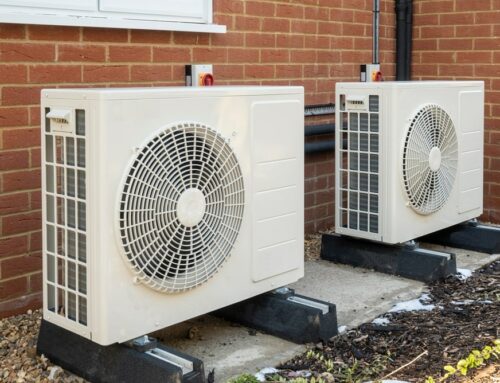The Mechanical Difference Between Heat Pumps and Gas Fired Furnaces
Considering a heat pump or need heat pump repair? Santa Rosa CA based JW Hanson Heating and Air Conditioning are the North Bay experts. This post, the second in a series, is from Will Hanson as he discusses the difference between heat pumps and gas-fired furnaces.

Curious about the difference between a heat pump and gas-fired furnace? This post dives into the technical differences.
From my previous article, you may understand the simplified difference between a heat pump and a gas fired furnace.
In short, a heat pump works like an air conditioner with the same principle of heat absorption and rejection, just in reverse. However, this simple explanation of the basic operation misses a lot of the nuance of the systems and their performance.
If you have a gas fired heating system, you have probably become accustomed to the quick response and the very warm to hot air you get from the vents. A furnace in a 1200 square foot home is often sized at 60,000 BTU and will deliver air at 120 degrees or warmer.
That same home with a heat pump will have a capacity of no more than 42,000 BTU and the air delivery temperature will vary greatly depending on the outdoor temperature. On a 45-degree day, a heat pump will do fairly well. The demand for heat in the home is relatively low and the available heat outside is relatively high. Even a fixed speed simple heat pump will produce 115–120-degree air in the situation.
However, as the need for heat increases and the temperature outside decreases, the situation changes. A fixed speed heat pump operating without auxiliary resistance heat will struggle to deliver 95-degree air at the vents if it is 38 degrees outside. In cooler temperatures, the need for heat is higher. If you come home to a 50 degree home on a winter night and turn on a fixed speed heat pump, don’t take off your coat!
It will take hours before the home is warm and comfortable and the air from the vents will be roughly 80-degrees. While 80-degree air from the vents will raise the temperature of the home, moving air must be significantly warmer than your skin temperature to feel warm. 95-degree air moving over your skin will feel warm but not hot. 80-degree air feels cool as it moves over your skin. A modulating heat pump will generally put out much higher air temperatures even in cooler weather.
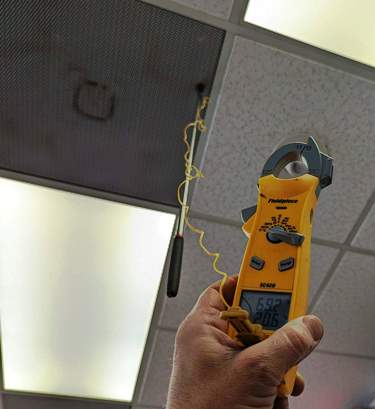 However, when the outdoor temperature drops into the 20’s, you will see a reduction in performance. Usually, a modulating heat pump will still produce fairly warm air, but less of it. Meaning it will run the indoor blower at a lower speed and it will go into the defrost cycle more often. During the defrost cycle, a heat pump does not produce any heat.
However, when the outdoor temperature drops into the 20’s, you will see a reduction in performance. Usually, a modulating heat pump will still produce fairly warm air, but less of it. Meaning it will run the indoor blower at a lower speed and it will go into the defrost cycle more often. During the defrost cycle, a heat pump does not produce any heat.
What is the defrost cycle? We are not talking about taking a steak out of the freezer. This is an unavoidable effect of operating a heat pump. First, let’s talk about a similar thing that happens with an evaporator coil when you are running the air conditioner in your car while it’s parked.
You may have noticed a small puddle that formed under your car when you pulled out from the parking space. This is just condensation that forms on the evaporator coil in your car. Just like a cold glass of water left out on the table on a hot day, condensation forms on surfaces that are colder than the surrounding space.
So, what does this mean for indoor climate control? With the air conditioning coil, this is a good thing. The condensation removes humidity from the hot air in the house and dry air feels cooler than humid air at the same temperature. This is due to evaporation of moisture on our skin happening more efficiently in dry air.
In a heat pump application, the same condensation is happening outside on the heat absorption coil. In the winter, when it is 42 degrees outside and the system is heating your home, the heat pump draws that 42-degree air across the outdoor coil and extracting heat from it to bring inside.
The air then being blown out of the heat pump condenser can be very cold. The cold coil that is absorbing heat outside also forms condensation. It is very normal for this condensation to freeze on the coil outside and as it freezes, it blocks the air flow.
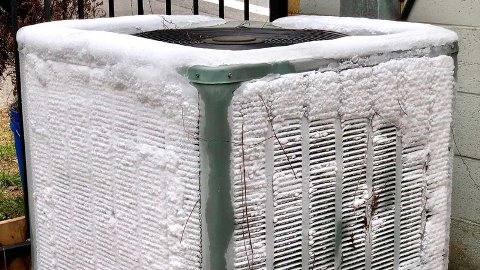 If enough air flow is blocked, the ice insulates the heat exchanger and prevents air movement. This triggers the unit to go into the defrost cycle, which manufacturers have used for years to remove the ice from the coil.
If enough air flow is blocked, the ice insulates the heat exchanger and prevents air movement. This triggers the unit to go into the defrost cycle, which manufacturers have used for years to remove the ice from the coil.
With the older, simpler systems, this function was based on a timer and the defrost cycle would run even if it didn’t need to when the timer triggered it. However, newer equipment uses a defrost cycle called demand defrost. The simplest form of demand defrost uses a temperature sensor that references the outdoor coil temperature before running the cycle.
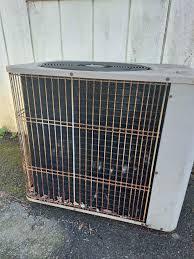 A more sophisticated heat pump, such as Mitsubishi, will trigger the defrost cycle based on an algorithm which references multiple sensors in the equipment including the refrigerant pressure, the run time to finish the cycle and the outdoor temperature.
A more sophisticated heat pump, such as Mitsubishi, will trigger the defrost cycle based on an algorithm which references multiple sensors in the equipment including the refrigerant pressure, the run time to finish the cycle and the outdoor temperature.
Why bother with using an algorithm to trigger the defrost cycle as opposed to a timer or just a temperature sensor? Well, the defrost cycle is expensive. It consumes a lot of energy, and it slows down the heat production in the house. However, if ice on the outdoor unit is stopping production, there isn’t really an option.
When the cycle starts on a simple heat pump two things happen. First, the outdoor blower stops running and the refrigerant reverses direction. This means it switches to cooling mode. Cooling mode when you need heat???This makes it clear why it is important to only run the defrost cycle when it is absolutely necessary.
After the simple fixed speed heat pump reverses the refrigerant flow, it starts to pull heat back out of the house to put it into the outdoor coil. This allows the hot refrigerant to condenser in the outdoor coil and melt the ice. A simple system will usually run for about 15 minutes before returning to the normal heating operation.
If you are outside near the heat pump when this happens, it sounds and looks like there is something wrong with the system. The effect is big in the house too…Remember, it switches to cooling and it’s already cold outside. If the outdoor coil that is made to reject the heat is encased in ice, it will absorb a lot of heat in that cycle.

This means the air coming out of the vents can be extremely cold during this cycle. Usually a lot colder than normal air conditioning air. If you are lucky, the installer put in auxiliary resistance heat that will energize during the defrost cycle and raise the temperature of the air about 20 degrees or so. The air is still cold, but not quite as bad.
What happens when a more sophisticated heat pump is running the defrost cycle? Well, a lot of the same things happen. However, Mitsubishi and other more advanced heat pump manufacturers will stop the indoor blower (or at least close the damper on the ductless unit) so it is not blowing cold air directly into the house.
They tend to defrost faster and after the cycle is complete, they don’t resume normal fan operation inside until the indoor coil has heated up enough to deliver warmer air. This means that although you may notice the defrost cycle is running when the system stops normal operation, you won’t experience extremely cold air in the house during the cycle.
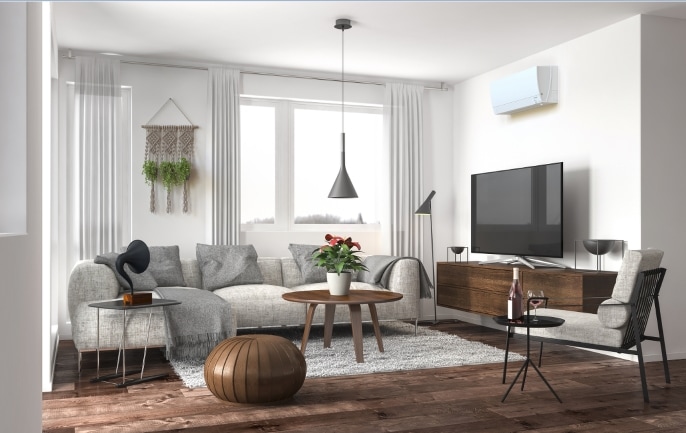 When you talk about the technical aspects of heat pumps, there is a lot to look at. One of the things that has a significant effect is the humidity outside. A 45-degree day with 35% humidity has far less energy in a cubic foot of air than the same 45-degree day with heavy rain. All of the moisture in the air carries a lot of energy.
When you talk about the technical aspects of heat pumps, there is a lot to look at. One of the things that has a significant effect is the humidity outside. A 45-degree day with 35% humidity has far less energy in a cubic foot of air than the same 45-degree day with heavy rain. All of the moisture in the air carries a lot of energy.
Heat pumps heat really well in high humidity and rain. This can result in more freezing on the outdoor coil but between the defrost cycles, more heat is absorbed. A cold, dry day has a heat pump working harder due to the lower energy saturation in the air. It’s a lot harder to extract heat energy from air that is thermally thin. Without the moisture, the air contains very little thermal energy.
The short answer is heat pumps tend to run longer cycles and deliver colder air but they do get the job done. They have a defrost cycle that can happen a lot in the right weather, but if the installer did their job correctly with the right equipment, this can be mitigated.



